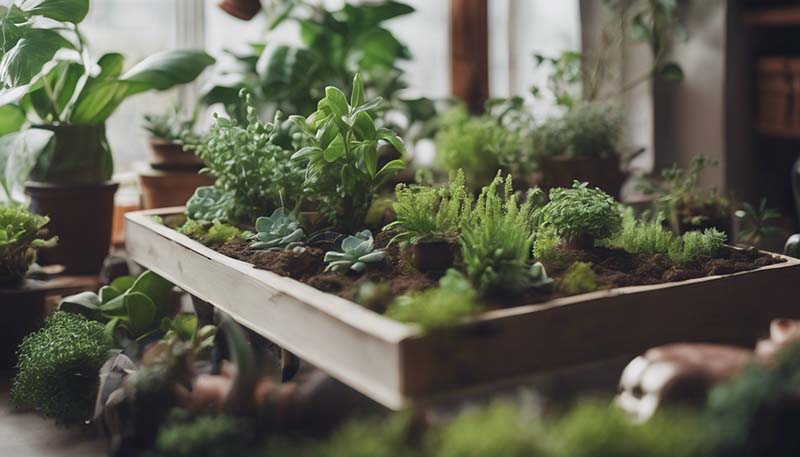Indoor Gardening: How to Create a Green Space in Your Home
Creating an indoor garden can transform your living space into a serene oasis, providing numerous benefits from improving air quality to reducing stress. Indoor plants can also add a touch of nature to an otherwise sterile environment, enhancing the aesthetic appeal of your home. In this article, we will explore the steps to create a thriving indoor garden and the benefits it can bring to your daily life.
Understanding Your Space
Before you start, it's important to consider the space you have available and the light conditions in your home. Different plants have different light requirements, so choose a location that best suits your plants' needs.
Light Requirements
- Low Light Plants: These plants can thrive in rooms with little to no direct sunlight, such as snake plants, pothos, and ZZ plants.
- Medium Light Plants: They prefer indirect or filtered light, like the peace lily or dragon tree.
- High Light Plants: These need plenty of bright, indirect light, such as fiddle leaf figs or rubber plants.
Selecting the Right Plants
Choose plants that are not only visually appealing but also suitable for your living conditions. Consider the following:
Advertisement
- Air Purifying Plants: Some plants are known to improve air quality by filtering out toxins. Examples include spider plants, aloe vera, and English ivy.
- Size and Growth Habit: Consider the mature size of the plant and how quickly it grows to ensure it will fit well in your space.
- Maintenance Level: Some plants are low-maintenance, while others may require more frequent watering and care.
Container Gardening
Container gardening is a popular choice for indoor spaces. It offers flexibility and the ability to move plants around as needed.
Choosing the Right Containers
- Drainage: Ensure your pots have drainage holes to prevent root rot.
- Material: Ceramic, terracotta, plastic, or even repurposed items can serve as planters.
- Style: Choose containers that complement your home decor and the plants they will house.
Soil and Planting
The quality of the soil is crucial for your plants' health. Use a well-draining potting mix and consider enriching it with compost or other organic matter.
Planting Tips
- Root Space: Give roots enough space to grow; overcrowding can lead to stress and disease.
- Planting Depth: Plant at the same depth they were at in their original container.
- Support: Use stakes or other support structures if needed, especially for climbing or tall plants.
Watering and Feeding
Watering needs vary greatly depending on the plant species, size of the pot, and environmental conditions. Overwatering is a common mistake, so it's important to learn the specific needs of your plants.
Watering Guidelines
- Check the Soil: Before watering, check if the top inch of soil is dry.
- Amount: Water thoroughly, allowing excess to drain out.
- Frequency: Establish a watering schedule based on your plants' needs.
Pruning and Maintenance
Regular pruning helps to maintain the shape and size of your plants and can encourage bushier growth.

Pruning Tips
- Timing: Prune most plants in the spring or early summer, except for those that flower in the fall.
- Tools: Use clean, sharp tools to make clean cuts and prevent disease.
- Branch Selection: Remove dead, diseased, or damaged branches first, then shape the plant as desired.
Dealing with Pests and Diseases
Pests and diseases can harm your indoor garden. Regularly inspect your plants for signs of infestation or illness and treat promptly.
Organic Pest Control
- Neem Oil: A natural pesticide that can be used to treat a variety of pests.
- Diatomaceous Earth: Can help control pests like spider mites and ants.
- Companion Planting: Some plants can deter pests that bother other plants.
Creating a Themed Indoor Garden
For a more curated look, consider creating a themed indoor garden. This could be based on color, plant type, or even a specific ecological environment like a desert or tropical garden.
Theme Ideas
- Desert Garden: Use cacti and succulents that require minimal watering.
- Tropical Garden: Choose large-leafed plants and consider using a humidifier to maintain humidity levels.
- Herb Garden: Plant culinary herbs that can be used in cooking.
Conclusion
Indoor gardening is a rewarding hobby that can bring numerous benefits to your home. With careful planning, selection of the right plants, and proper care, you can create a beautiful green space that enhances your living environment. Remember, the key to a successful indoor garden is understanding the needs of your plants and providing the best conditions for them to thrive.
Note: This article is intended as a guide. For detailed information, consult with a local horticulturist or extension service.
Comment